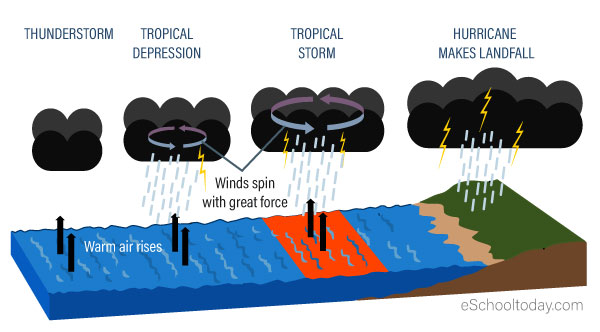- Hurricanes
How do hurricanes form?
Hurricanes only form over warm ocean waters of about 80°F. It explains why it is common in the tropics, where temperatures are high all year round. Hurricanes also need wind action to form. Now here is the fun part:
(use this illustration as a guide)

Warm air, together with moisture from evaporation from the ocean surface rises, creating low pressure on the water surface, which is immediately replaced by cooler air. This process continues, and the resulting moisture-laden clouds begin to expand. Thunderstorms with rains form.
The thunderstorms with rains begin to move slowly with mild western winds (a lot of wind action will disperse the buildup). In a day or two, stronger vertical currents build up over the ocean surface upward. More warm air rises, and the winds begin to move in a circular manner, caused by the earth’s rotation. The rising warm air causes pressure to decrease at higher altitudes. The entire system is now in a circular motion around a central point. This is called a tropical depression, and they have wind speeds going up to about 38 miles per hour.
In a couple of days, as the system moves over warmer waters, the clouds expand even more, and the winds begin to speed up. Gale force winds, thunderstorms, and heavy rains are in full force at this point. This may be called a tropical storm, and they have wind speeds up to 74miles per hour.
Continuing its movement westward, the tropical storm may be moving over even warmer waters. The energy from the warm ocean, in the form of very warm air rising and the gushing of cooler air replacing it throws the entire storm into a fury of a powerful, huge and monstrous spiral storm that can be seen from space. The spiral has a calm center called the eye.
The eye is surrounded by a towering and extremely dangerous vertical movement of thunderstorms. This is called the eyewall. The winds of the eyewall are so powerful that it spins and carries huge amounts of ocean water as it moves ashore.
The hurricane has now made a landfall (has reached land). With winds over 74mph to about 160mph, massive destruction is usually inevitable. As the system is no more over water, its fuel has run out and begins to ease out. The winds will subside and eventually end, but the rains may continue.
Landfall
This is when a hurricane reaches the coast and begins to travel over the land. It usually does not last for long as its fuel (warm ocean) is cut off, even though the thunderstorms and rains may continue for a while.
